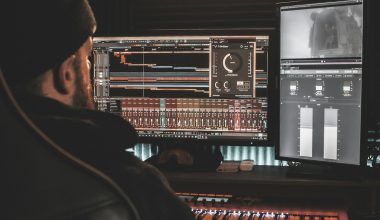Imagine listening to your favorite song, watching a movie, or even hearing the ringtone on your phone. All of this happens because of something called an audio format. But what is it exactly? Audio formats are like containers that store sound in digital form. Just like a suitcase keeps your clothes safe, audio formats keep music, speech, and sounds ready to play whenever you want.
But not all audio formats are the same. Some are perfect for super-clear, studio-quality sound. Others focus on being small and easy to share. Understanding these formats helps you pick the right one for your needs, whether you’re saving space on your phone or making music for millions to hear.
Different Types of Audio Formats
To keep it simple, audio formats can be divided into three types:
- Uncompressed Formats – These are like fresh juice: nothing is taken away. You get the purest sound, but the files are huge.
- Lossless Formats – These are like packed juice: it’s the same as fresh but smaller in size because the extra space is removed.
- Lossy Formats – These are like juice powders: they still taste good, but a lot has been simplified to make it quick and portable.
1. Uncompressed Audio Formats
Uncompressed formats are the rawest and purest forms of sound. They keep every detail, which makes them sound amazing but also take up a lot of storage space.
WAV (Waveform Audio File Format)
- What it is: This is like a high-resolution photo but for sound.
- Who uses it: Mostly musicians, studios, and editors who need top-notch quality.
- Pros:
- Amazing quality
- Easy to edit
- Works on almost all devices
- Cons:
- Huge file size (one song can take up 40–50 MB!)
AIFF (Audio Interchange File Format)
- What it is: Think of it as the Apple version of WAV.
- Who uses it: People using Apple devices for music production.
- Pros:
- Excellent sound quality
- Great for editing
- Cons:
- Big file size
When to use uncompressed formats:
- If you’re recording or editing audio.
- If you want the best sound quality, no matter the file size.
2. Lossless Audio Formats
Lossless formats are smaller than uncompressed ones but still keep all the sound details. It’s like folding your clothes neatly to fit more into your suitcase without leaving anything behind.
FLAC (Free Lossless Audio Codec)
- What it is: A popular format for audiophiles (people who love high-quality sound).
- Who uses it: Music lovers who want their collections to sound amazing.
- Pros:
- Keeps the original sound quality
- Compresses files to save space
- Free and works on most devices
- Cons:
- Not supported by some older players
ALAC (Apple Lossless Audio Codec)
- What it is: Apple’s version of FLAC.
- Who uses it: Apple users who value sound quality.
- Pros:
- Great for iPhones, iPads, and MacBooks
- Keeps sound quality intact
- Cons:
- Limited to Apple-friendly platforms
When to use lossless formats:
- If you want high-quality sound but need smaller file sizes than WAV or AIFF.
- For storing music on modern devices or streaming from high-res services like Tidal or Amazon Music HD.
3. Lossy Audio Formats
Lossy formats are all about saving space. They simplify the audio by removing parts of the sound that most people can’t hear. The result? Smaller files that are quick to download or stream.
MP3 (MPEG Audio Layer-3)
- What it is: The most common audio format in the world.
- Who uses it: Everyone! From students to professionals, anyone who needs a small file that works anywhere.
- Pros:
- Tiny file size
- Compatible with all devices
- Cons:
- Not as sharp or clear as other formats
AAC (Advanced Audio Codec)
- What it is: A newer and better-sounding cousin of MP3.
- Who uses it: Streaming platforms like Spotify and YouTube.
- Pros:
- Better sound quality than MP3 at the same file size
- Widely supported
- Cons:
- Slightly less universal than MP3
OGG (Ogg Vorbis)
- What it is: An open-source format often used in video games and online streaming.
- Who uses it: Gamers and niche music platforms.
- Pros:
- Free to use
- High-quality sound
- Cons:
- Limited compatibility
When to use lossy formats:
- If you need to save storage space.
- For streaming or downloading music on the go.
How to Pick the Right Audio Format
Now that you know about the different types, how do you choose? Here’s an easy guide:
- Sound Quality: Pick WAV, AIFF, or FLAC.
- Saving Space: MP3 or AAC is your best friend.
- Compatibility: Go with MP3—it works everywhere.
Comparing Audio Formats
Here’s a quick comparison to help you decide:
| Format | Quality | File Size | Best For |
|---|---|---|---|
| WAV | Excellent | Very Large | Professional Use |
| FLAC | High | Medium | Audiophile Listening |
| MP3 | Good | Small | Everyday Listening |
| AAC | Very Good | Small | Streaming Platforms |
FAQs About Audio Formats
1. Why do some formats sound better than others?
It’s all about how much data is stored. Formats like WAV and FLAC keep more details, making them sound clearer.
2. Why are MP3 files so popular?
MP3 files are small, easy to share, and work on almost every device.
3. What’s the difference between FLAC and MP3?
FLAC keeps all the original sound details, while MP3 simplifies the audio to save space.
The Future of Audio Formats
As technology improves, more people are moving to lossless formats like FLAC and ALAC. With faster internet speeds and better storage options, we’ll see less compromise on quality. Even streaming platforms are offering lossless music options to enhance the listening experience.
Conclusion
Understanding different audio formats doesn’t have to be complicated. It’s about finding the right balance between sound quality, file size, and how you’ll use the audio. Whether you’re saving space with MP3, enjoying high-fidelity music with FLAC, or producing tracks in WAV, there’s a format that fits your needs.
So, the next time you download a song or save a recording, think about the format—it can make all the difference in how you enjoy your sound!
Related Articles:
For further reading, explore these related articles:
- How to Become a Successful Music Artist in India in 2024?
- Promo Cards on Spotify: A Game Changer for Artists
For additional resources on music marketing and distribution, visit Deliver My Tune.






